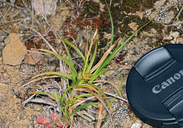notes [Note: To view complete detail of the full-size image, click this link...then click the image again after it loads in your browser window.]
This small 'clump-let' of Carex consists of ~3 closely-packed clusters of living green leaves, together with some gray remains of previous season's leaves...all presumably emanating from a single short rhizome. The clump-let was growing on a very small rocky opening within surrounding mountainside grassland. This isolated plant contrasts sharply with the large & densely-contiguous patches of the same Carex species that were growing nearby within the surrounding grassland (e.g. see this iNaturalist post).
To give a sense of scale here, the lens cap seen in the photo has a diameter of 58 mm...and it could cover most of the plant! Using the lens cap as a reference length, I was able to estimate measurements of various plant parts which can help in species diagnosis. The arching, glabrous leaves are ~2 mm wide & up to ~8 cm long. There are two very short-stalked pistillate spikes at the base of the plant's central leaf cluster, and between them arises a stem about 3 cm long supporting another inflorescence with a lateral pistillate spike below and a terminal staminate spike above (for a nice illustrated presentation of Carex-related terminology, see pp. 5-15 of this USDA publication). The immature staminate spike in the photo is ~11 mm long, the pistillate spikes are ~5-8 mm long, and the narrow green bract subtending the elevated inflorescence is ~17 mm long...exceeding the length of that inflorescence. As can best be seen in the last few photos of this series, the perigynia are pubescent with 2 relatively-pronounced nerves (and perhaps a few more weakly-defined ones), and are about 4 mm long (including the tapered beak) and ~2 mm wide...and the pistilate scales vary in length from slightly-shorter to slightly-longer than the perigynia they subtend.
Consulting the Jepson eFlora Carex key, the glabrous leaves & hairy perigynia here lead immediately to the Group 2 subkey, and from there the keying sequence appears straight-forward until one reaches couplet 12:
12. Inflorescence bracts on taller (non-basal) stems inconspicuous, scale-like, < inflorescence; old leaves occasionally persisting as shredded fibrous tufts; peri 1.5–2.1 mm wide; coastal dunes, headlands, NCo, CCo ..... C. brevicaulis
12' Inflorescence bracts on taller (non-basal) stems prominent, leaf-like, generally >= inflorescence; old leaves not persisting as shredded fibrous tufts; peri 1–1.7 mm wide; NCo, CCo, and elsewhere.....13 [Red and bold emphasis above are mine]
Note that, in my photos, the length of the bract subtending the pistillate spike in the (non-basal) inflorescence is longer than the inflorescence...so the primary discriminant presented in couplet 12 would prompt one to go with the 2nd lead (eventually leading to C. rossii). But the other discriminants in the 1st lead of couplet 12 (i.e. persistent old leaves; perigynia 1.5-2.1 mm wide; and more coastal habitat) suggest C. brevicaulis. So which lead should one take at this couplet??
Hoping to resolve the ''bract > inflorescence'' glitch above, I consulted the Flora of North America Carex key...which eventually led me to a similar 'bract length conundrum' at couplet 5 of their Carex Sect. Acrocystis subkey. So, again, I was unclear on which lead to choose.
However, upon reading the FNA description of C. brevicaulis, I noticed it states:
''...proximal nonbasal bracts scalelike, usually equaling or shorter than inflorescences, rarely longer.'' [Bold emphasis mine]
And, moreover, the FNA line drawing for C. brevicaulis (see here) is a remarkably good fit to my photos here, and in particular illustrates the 'proximal nonbasal bract' as being much longer than the subtended inflorescence spikes. That line drawing also clearly conveys the distinctly arcuate (or 'sickle-shaped') leaves seen in my photos...whereas the FNA drawing for C. rossii indicates longer, straighter, and more erect leaves. The above, taken together with a careful comparison of the FNA descriptions of both species helped persuade me that C. brevicaulis is the better placement here. Moreover, studying the 'Carex Working Group's' key here also led me to C. brevicaulis...and they indicate the inflorescence bract in C. brevicaulis can be leaf-like or scale-like and (rarely) longer than the inflorescence (see ''Table 33'' on pg. 25 of their ''Conspectus Tables'' here).
Further support for an ID of C. brevicaulis is provided by a personal communication from Kenny Hickman that local CNPS graminoid master John Rawlings has found numerous stations of C. brevicaulis on San Bruno Mountain (cf. their related records from nearby Sweeney Ridge and Scarper Ridge...as well as the these older CCH vouchers for C. brevicaulis from San Bruno Mnt by the renowned 20th century botanist John Thomas Howell).
Postscript (4/2/23): I'm changing the name placement here from C. brevicaulis to Carex rossii...based on discussion in the comments thread under my companion iNat post. First, Barbara Wilson (of the 'Carex Working Group') indicated that usage of the name 'C. brevicaulis' here is nomemclaturally problematic...and those problems can be addressed by using the replacement name C. zikae (see this 'Tropicos' web page, and the 2015 'Carex Working Group' paper here).
Second, Barbara thinks there are still problems with the taxonomy of this group, but at this point it would probably be best to place this as C. rossii, since C. zikae is associated with sandy habitat more immediately adjacent to the coast.
photo category: Plant - annual/perennial
